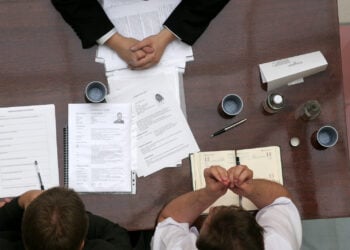We talk about athletes being “in the zone” when they hit their stride in performance and competition. The type of training that enables individual athletes to tap into peak “zones” varies from person-to-person and sport-to-sport. Coaches and trainers recognize that individual athletes bring different strengths, talents, dispositions, life experiences, confidence levels, physiques, and motivational drivers to their sport—and tailor training accordingly.
A one-size-fits-all training approach just wouldn’t work to get the most out of each athlete, to cultivate them to fulfill their true potential. Like the athletic arena, the legal profession is performance-driven. Yet legal training tends to reinforce a mostly uniform training model—the same general content and paradigms we’ve been drilling into law students and new lawyers for decades. Our current approach overlooks the reality that, like athletes, each of us learns, recovers from mistakes, processes stress, and flourishes—differently.
Let’s borrow a few pages from athletic coaches’ playbooks. Let’s consider how we can adjust legal training so each individual can soar. As a start, let’s explore three zones familiar to many athletes: the Individual Zone of Optimal Functioning (IZOF), the eustress zone, and flow.
What’s your lawyering IZOF?
For decades, sports psychologists have studied the relationship between emotions and athletic performance. Athletes and their coaches realize that various combinations and degrees of positive and negative emotions can both enhance and hinder performance. The optimal tenor, mixture, and intensity of emotions for peak performance in sports training and competition depends on the person. In the 1970s, a Russian sports psychologist named Dr. Yuri Hanin determined that individual athletes each have a personalized state of emotional and physiological “arousal”—a condition of alertness and preparedness for movement and exertion—in which they perform at their best. He calls this state the Individual Zone of Optimal Functioning (IZOF).
Individual zone. Not the one-size-fits-all zone.
Hanin’s early research focused on anxiety—specifically, the link between individual athletes’ optimal anxiety levels and their performance in sports training and competition. Later, Hanin and his colleagues broadened their inquiry, analyzing four categories of emotions and their respective effects on individual athletes’ performance:
- Positive emotions that can be optimal for performance, such as purposefulness and resoluteness.
- Positive emotions that can be suboptimal for performance, such as easygoingness and satisfaction.
- Negative emotions that can be optimal for performance, such as tenseness and dissatisfaction.
- Negative emotions that can be suboptimal for performance, such as distress and fear.
Overall, Hanin and his colleagues determined that whether a particular emotion is constructive or destructive depends on the athlete. Importantly, when individual athletes become knowledgeable about their unique zones of optimal physiological and emotional arousal and consciously strive to operate within those states, they deliver peak performance. Outside such zones, performance declines. Great athletes, with the help of their coaches, study and get to know their IZOF.
Lawyers, like athletes, bear a lot of pressure to deliver peak performance in high-stakes scenarios. Emotion (pathos) comprises one of Aristotle’s three pillars of persuasion—along with logical reasoning (logos) and credibility (ethos). But often it seems we dismiss the role of emotion in legal training. It’s time we create space in legal training to talk realistically about emotions; to study how different shades of positive and negative emotions can optimize or hinder our learning and performance; and to consider environments, scenarios, interpersonal dynamics, and tasks in which we individually deliver our best work. Lawyers should get to know their IZOF.
What’s your ‘eustress’ zone?
Another concept we should incorporate into legal training is the “eustress” zone. In the mid-1970s, Dr. Hans Selye—a pioneer in stress research—introduced the concept of “eustress.” The “eu” in the word comes from the ancient Greek for “good, well, pleasant, or true.” Selye distinguished among stress, eustress, and distress. Eustress is a waystation between stress and distress, a zone in which we purposefully engage with stressors we know we are equipped to handle. In sports training, eustress is the zone in which athletes intentionally step into temporary states of discomfort, pushing their brains and bodies, knowing they have the coping skills to ride out the rise and fall of physiological and emotional arousal. Instead of automatically leaping from stress to distress, athletes activate strengths they have honed, choosing to linger in eustress, building additional stamina to handle future challenges. Later, in performance moments, when they encounter similar physiological and emotional responses to new stressors, they trust their training, and deliver.
As lawyers, we can invest time in learning how to toggle into a state of eustress—good stress—instead of blindly catapulting from stress to distress. Like IZOF, engagement in the eustress zone requires self-study. We can observe the natural rise and fall of physical and emotional sensations triggered by inevitable stress, develop healthy coping routines, and practice activating stress management techniques to stay in the eustress zone in training. Ultimately, in lawyering performance moments, we trust our training, and deliver quality work.
What’s your ‘flow’ zone?
Positive psychologist, Dr. Mihaly Csikszentmihalyi, coined the term flow to describe “the state in which people are so involved in an activity that nothing else seems to matter.” He says flow can happen when “our body or mind is stretched to its limits in a voluntary effort to accomplish something difficult and worthwhile.” For athletes, flow is that zone in training or performance when everything just seems to click. A basketball player sinking one three-point shot after another. A gymnast nailing a floor routine. A marathoner hitting that runner’s high. But flow is not reserved for athletes. As lawyers, we can access and cultivate flow in our work.
Csikszentmihalyi and his colleagues compiled a list of nine components characterizing flow states for athletes (which likewise can apply to lawyers):
- A balance between a given challenge and our skill level.
- A clear goal for an activity or training session.
- A sense of control over the interim steps needed to accomplish the task.
- Unambiguous and immediate feedback (self-generated or external).
- An ability to tune out the world and concentrate on the task at hand.
- A melting away of boundaries between action and awareness.
- A loss of self-consciousness or self-judgment.
- Transformation of time.
- An “autotelic” experience, i.e., the activity is enjoyable in itself (without need for an external reward).
Maybe flow happens for you when you’re delivering an oral argument or an opening statement in the courtroom. Or perhaps you hit flow when you’re negotiating. Or putting a deal together. Or figuring out a creative solution to a tough legal quandary.
Legal writing is my flow state. I lose all sense of time and space. Challenge and skill settle into equipoise. When I eventually look up from my laptop, I’m disoriented. My hair is wild. I’m famished. And exhilarated.
Everyone deserves a flow state.
Flow can infuse meaning, purpose, and zest into our lawyering lives. But the circumstances and conditions that facilitate flow wildly differ for each of us. We can’t force or fake flow. To cultivate it, we must identify the particular activities, challenge levels, requisite skills, and environmental surroundings that get us into our individual groove. Flow is the opposite of one-size-fits-all.
![]()
So, how can we tap into our lawyering IZOF, eustress zones, and flow states?
First, let’s carve out a place in legal education and training to highlight the individuality of our strengths, interests, and learning styles.
Second, let’s enhance our emotional literacy. Let’s honor the role that emotion (pathos) inevitably plays in our day-to-day lawyering work and in our professional development. Let’s investigate and study how different emotions affect our confidence, cognitive clarity, and communication skills.
Third, let’s improve our emotional self-regulation. Let’s learn how to engage with constructive emotions and reframe suboptimal ones. Let’s get better at toggling ourselves into our IZOF and lingering in our eustress zone.
Fourth, let’s find and facilitate flow states. Let’s amp up skills training so we can meet rigorous challenges posed. Let’s curate environmental circumstances that allow us to concentrate, everything in us to click, and our best work to emerge. Like athletes in the zone.
Author Caroline Williams reminds us, we “are not a brain on legs.” Our intellect will only get us so far. Through greater appreciation and understanding of our emotional and physiological dimensions, we’ll reach new performance heights—as individuals and as a profession.










